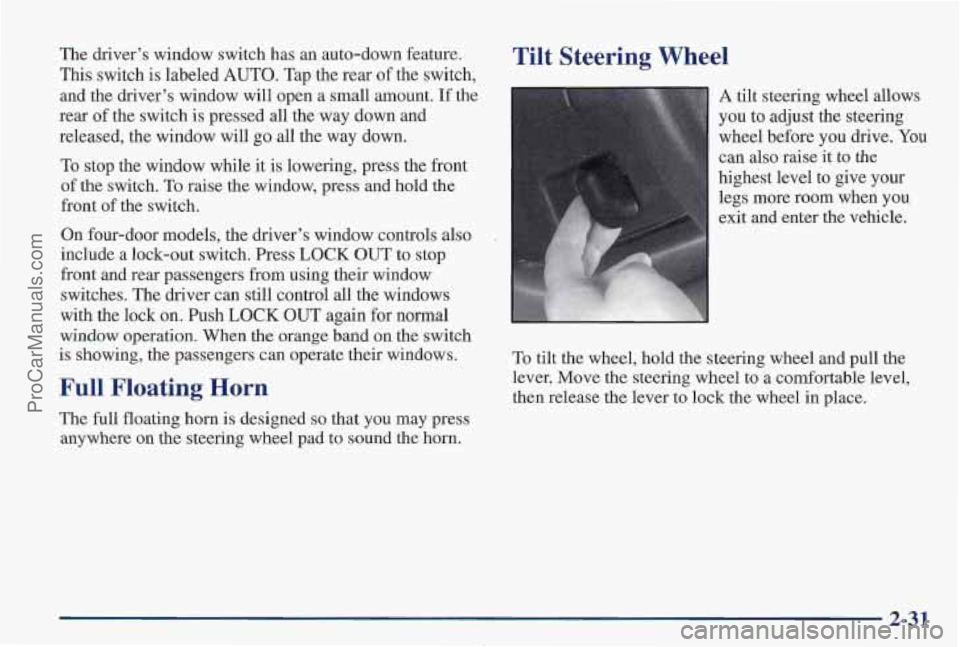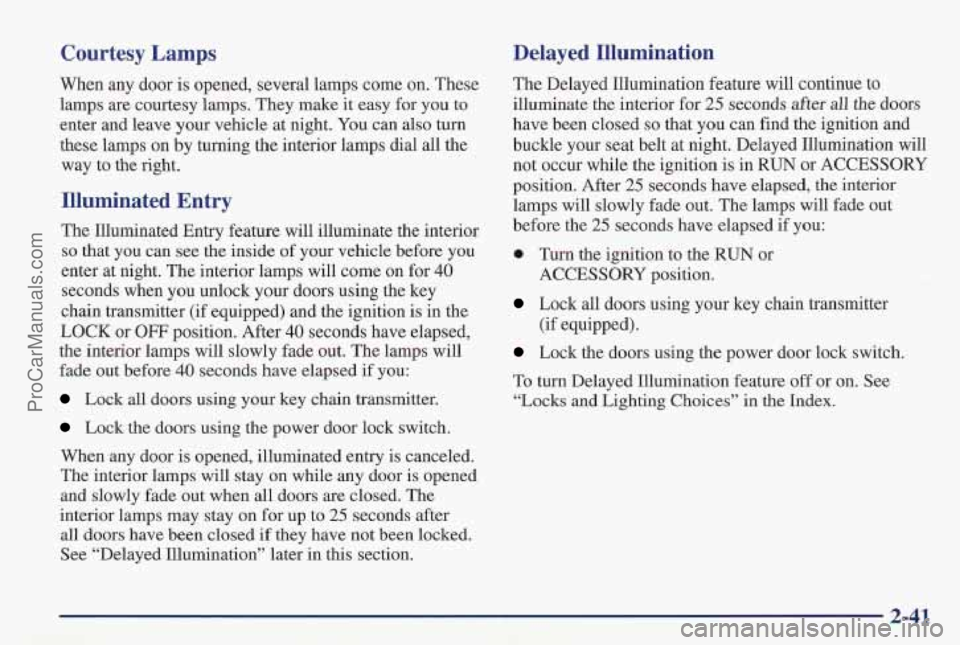1997 PONTIAC PONTIAC lock
[x] Cancel search: lockPage 96 of 419

FIRST (1): This position gives you even more power,
but lower fuel economy than
SECOND (2). You can use
it on very steep hills, or in deep snow or mud. If the shift
lever
is put in FIRST (1)’ the transaxle won’t shift into
first gear until the vehicle is going slowly enough.
NOTICE:
~~~~~~ ~
If your front wheels can’t rotate, don’t try to
drive. This might happen if you were stuck in
very deep sand or mud or were up against a solid
object. You could damage your transaxle.
Also, if you stop when going uphill, don’t hold
your vehicle there with only the accelerator
pedal. This could overheat and damage the
transaxle. Use
your brakes or shift into PARK (P)
to hold your vehicle in position on a hill.
Shift Lock Release (Console Shift)
If your vehicle’s battery should go dead, there are two override
access slots that will allow you to override
park lock.
The first is located
underneath the steering
column below the lock
cylinder.
To use this slot,
first remove the trim
cap.
Insert a key or screwdriver
into the access slot and
press
the lock cylinder.
You will now be able to remove your key from the
ignition. Be sure
to replace the trim cap after use.
If the car has a column mounted gear shift lever,
you will now also
be able to shift your vehicle out
of PARK (P).
2-22
ProCarManuals.com
Page 100 of 419

Move the lever up as far as it will go.
3, Move the ignition key to LOCK.
4. Remove the key and take it with you. If you can
leave your vehicle with the ignition key in your
hand, your vehicle is in
PARK (P).
Console Shift
I. Hold the brake pedal down with your right foot and
2, Move the shift lever into PARK (P) position like this:
set the parking brake.
3.
4.
Hold in the lever, located on the front of the shift
knob, and push the shift knob all the way toward the
front of your vehicle.
Move the ignition key
to LOCK.
Remove the key and take it with you. If you can
leave your vehicle with the ignition key in your
hand, your vehicle is in PARK (P).
2-26
ProCarManuals.com
Page 101 of 419

Leaving Your Vehicle With the Engine Running
It can be dangerous to leave your vehicle with
the engine running. Your vehicle could move
suddenly if the shift lever is not fully in PARK
(P)
with the parking brake firmly set. And, if you
leave the vehicle with the engine running, it could
overheat and even catch fire. You or others could
be injured. Don’t leave your vehicle with the
engine running unless you have to.
If you have to leave your vehicle with the engine
running, be sure your vehicle is in PARK (P) and your
parking brake is firmly set before you leave it. After
you’ve moved the shift lever into
the PARK (P)
position, hold the regular brake pedal down. Then, see if
you can move the shift lever away from PARK (P)
without first pulling it toward you (or, if you have a
console
shift lever, without first pushing the button). If
you can, it means that the shift lever wasn’t fully locked
into PARK (P).
Torque Lock
If you are parlung on a hill and you don’t shift your
transaxle into PARK (P) properly, the weight of the
vehicle may put too much force on the parking pawl in
the transaxle. You may find it difficult to pull the shift
lever out of PARK (P). This is called “torque lock.” To
prevent torque lock, set the parking brake and then shift
into PARK (P) properly before you leave the driver’s
seat.
To find out how, see “Shifting Into PARK (P)” in
the Index.
When you are ready to drive, move the shift lever out
of
PARK (P) before you release the parking brake.
If torque lock does occur, you may need to have another
vehicle push yours a little uphill to take some of the
pressure from the parking pawl in the transaxle,
so you
can pull the shift lever out of PARK (P).
2-27
ProCarManuals.com
Page 102 of 419

Shifting Out of PARK (P)
Your Pontiac has a Brake-Transaxle Shift Interlock.
You must fully apply your regular brakes before
you can
shift from
PARK (P) when the ignition is in RUN. See
“Automatic Transaxle Operation” in the Index.
If
you cannot shift out of PARK (P), ease pressure on
the shift lever by pushing it all the way into PARK
(P)
while keeping the brake pedal pushed down. Release the
shift lever button if you have
a console shift. Then move
the shift lever out of PARK (P), being sure to press the
shift lever button if you have a console shift.
If you ever hold the brake pedal down but still can’t
shift out of PARK
(P) with column shift, try this:
1. Turn the key to OFF.
2. Apply and hold the brake until the end of Step 4.
3. Shift to NEUTRAL (N).
4. Start the engine and shift to the drive gear you want.
5. Have the vehicle fixed as soon as you can.
With Console Shift
see “Shift Lock Release” section.
Parking Over Things That Burn
r
Things that can burn could touch hot exhaust
parts under your vehicle
and ignite. Don’t park
over papers, leaves, dry grass or other things that
can burn.
2-28
ProCarManuals.com
Page 105 of 419

The driver’s window switch has an auto-down feature.
This switch
is labeled AUTO. Tap the rear of the switch,
and the driver’s window will open a small amount. If the
rear of the switch is pressed all the way down and
released, the window will go all the way down.
To stop the window while it
is lowering, press the front
of the switch.
To raise the window, press and hold the
front of the switch.
On four-door models, the driver’s window controls also
include a lock-out switch. Press
LOCK OUT to stop
front and rear passengers from using their window
switches. The driver can still control all the windows
with the lock
on. Push LOCK OUT again for normal
window operation. When the orange band on the switch
is showing, the passengers can operate their windows.
Full Floating Horn
The full floating horn is designed so that you may press
anywhere on the steering wheel pad
to sound the horn.
Tilt Steering Wheel
A tilt steering wheel allows
you to adjust the steering
wheel before
you drive. You
can also raise it to
the
highest level to give your
legs more room when you
exit and enter
the vehicle.
To tilt the wheel, hold the steering wheel and pull
the
lever. Move the steering wheel to a comfortable level,
then release the lever to lock the wheel in place.
2-31
ProCarManuals.com
Page 108 of 419

For steady wiping at low speed, turn the band to LO. For
high-speed wiping, turn the band further, to
HI. To stop
the
wipers, turn the band to OFF.
You can set the wiper speed for a long or short delay
between wipes. This can be very useful in light rain or
snow. Turn the band
to choose the delay time. The
closer to
LO, the shorter the delay.
Be sure to clear ice and snow from the wiper blades
before using them.
If they’re frozen to the windshield,
carefully loosen
or thaw them. If your blades do become
damaged, get new blades
or blade inserts.
Heavy snow
or ice can overload your wipers. A circuit
breaker will stop them until the motor cools. Clear away
snow or ice to prevent an overload.
Windshield Washer
At the top of the multifunction lever, there’s a paddle
with the word
PUSH on it. To spray washer fluid on the
windshield, push the paddle. The wipers will run for
several sweeps and then either stop or return
to your
preset speed. See “Windshield Washer Fluid”
in
the Index.
In freezing weather, don’t use your washer until
the windshield is warmed. Otherwise the washer
fluid can form ice on the windshield, blocking
your vision.
2-34
ProCarManuals.com
Page 113 of 419

go : Turn the knob to this symbol to turn on the headlamps
and other operating lamps.
PG: Turn the knob to this symbol to turn on the parking
and other operating lamps without the headlamps.
Turn the knob to
OFF to turn off the lamps.
Daytime Running Lamps
Daytime Running Lamps (DRL) can make it easier for
others to see the front of your vehicle during the day.
DRL can be helpful in many different driving
conditions,
but they can be especially helpful in the
short periods after dawn and before sunset.
A light sensor on top of the instrument panel makes the
DRL work, so be sure it isn't covered.
The DRL system will make your low-beam headlamps
come on at a reduced brightness when:
0 The ignition is on,
0 The headlamp switch is off, and
0 The parking brake is released.
When the
DRL are on, only your low-beam headlamps
will be on. The taillamps, sidemarker and other lamps
won't be on. Your instrument panel won't be lit up either.
When it's dark enough outside, your headlamps will change to full brightness. The other lamps that come on
with your headlamps will also come on.
When it's bright enough outside, the regular lamps will
go out, and your low-beam headlamps change to the
reduced brightness of DRL.
To idle your vehicle with the DRL off, set the parking
brake while the ignition is in
OFF or LOCK. Then start
your vehicle. The DRL will stay
off until you release the
parking brake.
As with any vehicle, you should turn on the regular
headlamp system when you need it.
ProCarManuals.com
Page 115 of 419

Courtesy Lamps
When any door is opened, several lamps come on. These
lamps are courtesy lamps. They make
it easy for you to
enter and leave your vehicle at night. You can also turn
these lamps
on by turning the interior lamps dial all the
way to the right.
Illuminated Entry
The Illuminated Entry feature will illuminate the interior
so that you can see the inside of your vehicle before you
enter at night. The interior lamps will come on for
40
seconds when you unlock your doors using the key
chain transmitter (if equipped) and the ignition is in the
LOCK or
OFF position. After 40 seconds have elapsed,
the interior lamps will slowly fade out. The lamps will
fade out before
40 seconds have elapsed if you:
Lock all doors using your key chain transmitter.
Lock the doors using the power door lock switch.
When any door is opened, illuminated entry is canceled.
The interior lamps will stay on while any door is opened
and slowly fade out when all doors are closed. The
interior lamps may stay on for up to
25 seconds after
all
doors have been closed if they have not been locked.
See “Delayed Illumination” later in this section.
Delayed Illumination
The Delayed Illumination feature will continue to
illuminate the interior for
25 seconds after all the doors
have been closed so that you can find the ignition and
buckle your seat belt at night. Delayed Illumination will
not occur while the ignition is in RUN or ACCESSORY
position. After
25 seconds have elapsed, the interior
lamps will slowly fade out. The lamps will fade out
before the
25 seconds have elapsed if you:
0 Turn the ignition to the RUN or
Lock all doors using your key chain transmitter
Lock the doors using the power door lock switch.
To turn Delayed Illumination feature off or on. See
“Locks and Lighting Choices” in the Index.
ACCESSORY
position.
(if equipped).
2-41
ProCarManuals.com